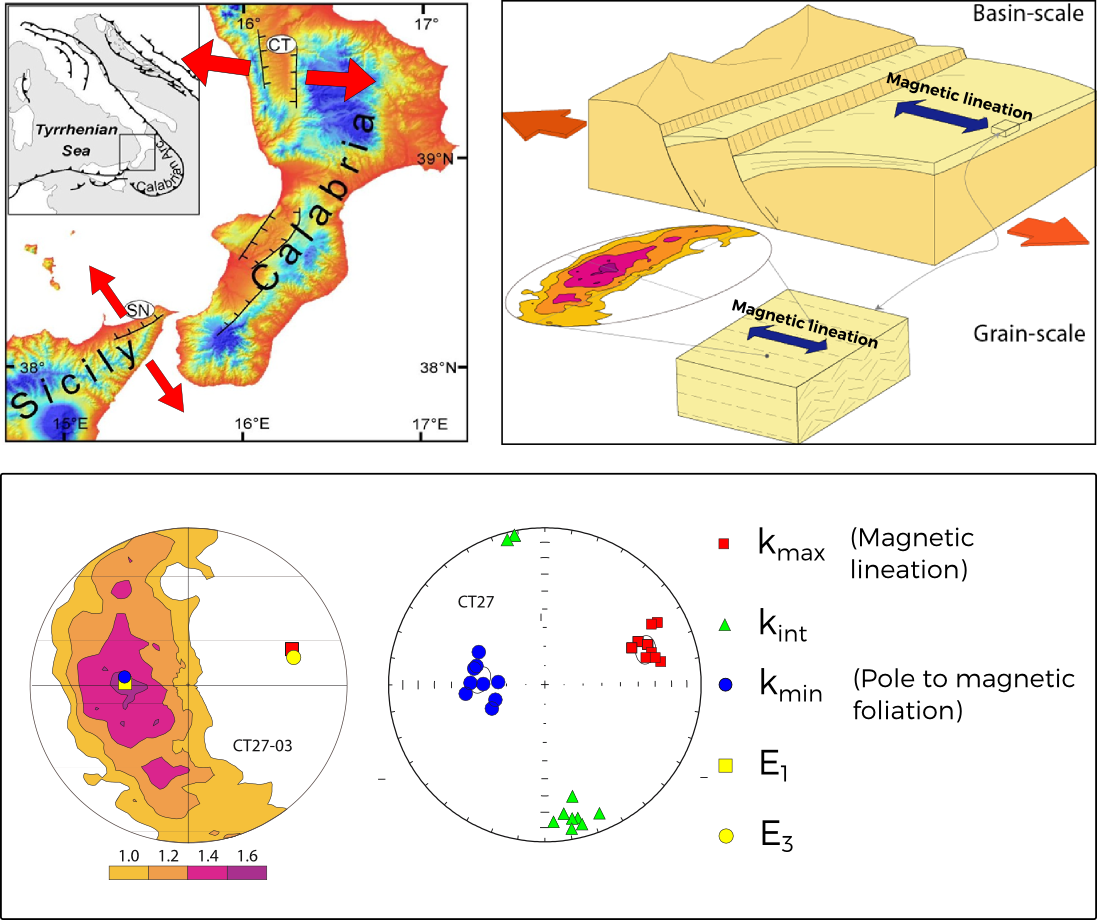Magnetic Fabric
Magnetic fabric is the assessment of rock fabric studied by the means of anisotropic behavior of magnetic properties and applicable to many fields of research, mainly structural geology, sedimentology, volcanology and tectonics. Preferred orientation of minerals is typical of almost all rock types. Magnetic minerals, mostly occurring in rocks in accessory amounts, show preferred orientation as well and this can be advantageously investigated by means of magnetic anisotropy, a technique based on directional variability in magnetic properties. For example, in magnetite grains, the susceptibility is the highest along the longest dimension of the grain, while it is the lowest along the shortest dimension regardless of the orientation of crystal lattice; this anisotropy being called the shape anisotropy. In paramagnetic phyllosilicates, magnetic susceptibility is higher within the basal plane than along the c-axis, thus constituting the magnetocrystalline anisotropy. If the magnetic grains are oriented preferentially in a rock, the rock shows magnetic anisotropy.
Case study

The origin of magnetic lineation in apparently undeformed clayey sediments filing the extensional basics in southern Italy.
The contour plot shows a within-sample distribution of c-axes of chlorite measured using neutron texture goniometry (Helmholtz-Zentrum Geesthacht, Germany). The maximum and minimum directions of the orientation matrix is distribution (E1, E3, respectively) coincide very well with the minimum and maximum directions of magnetic anisotropy tensor (Kmin, Kmax, respectively) obtained using an AGICO Kappabridge. With an aim of neutron texture goniometry, magnetic lineation is interpreted as being parallel to the common axes of chlorite basal planes and reflecting the direction of basin-scale extensition. Note that the acquisition of the neutron diffraction data required ca. 20 hrs. while the anisotropy tensor was measured within minutes allowing to measure multiple specimens per site in order to obtain the statistically sound data. Courtesy F. Cifelli.
The magnetic fabric is conveniently represented by an ellipsoid, from which are derived several parameters characterizing the preferred orientation of magnetic minerals. The degree of anisotropy quantifies the intensity of the preferred orientation of magnetic minerals and the shape parameter described the character or symmetry of the preferred orientation being prolate, neutral, or oblate. The orientation of the principal fabric directions defines the so-called magnetic foliation and magnetic lineation which inform us of the directional alignment of magnetic minerals and can be evaluated in a similar way as the mesoscopic fabric element conventionally measured in the structural geology.
The most frequently used type of magnetic anisotropy is the Anisotropy of Magnetic Susceptibility (AMS), which can be measured using AGICO Kappabridges (current models are MFK2 and KLY5). Using the recently developed 3D rotator, the measurement is fully automated with measurement of one specimen taking less than 2 minutes. Alternatively, in order to address the fabric carried by ferromagnetic minerals, Anisotropy of Magnetic Remanence (AMR) can be measured using AGICO Spinner Magnetometer (current models are JR-6 / JR-6A) in conjunctions with an AGICO Anhysteretic / Pulse Magnetizer (current model is LDA5 / PAM1). Magnetic fabric data can be very easily processed and visualized by AGICO Anisoft software which gained a wide popularity due to its easy-to-control and straight forward user interface.
Scientific notes on Magnetic Fabric
| Note on use of AMS for research of Tectonic proceses | Download |
| Note on Separation of Magnetic Fabrics | Download |
| Note on Flow directions in Rocks | Download |
More details can be found in publications below
Hrouda, F., 2011, Anisotropy of Magnetic Susceptibility in Variable Low-Fields: A Review. Petrovský, E., Ivers, D., Harinarayana, T. & Herrero-Bervera, E. (ed.) The Earth's Magnetic Interior Chapter Anisotropy Springer Netherlands, pp. 281-292, DOI
Hrouda, F., 2007, Magnetic susceptibility, anisotropy. Gubbins, D. & Herrero-Bervera, E. (ed.) Encyclopedia of Geomagnetism and Paleomagnetism pp. 546-560, URL
Hrouda, F., 1982, Magnetic anisotropy of rocks and its application in geology and geophysics. Geophysical Surveys, Vol. 5(1), pp. 37-82, DOI
Cifelli, F., Mattei, M., Chadima, M. et al., 2005, The origin of tectonic lineation in extensional basins: Combined neutron texture and magnetic analyses on "undeformed" clays", Earth and Planetary Science Letters, Vol. 235 (1-2) , pp. 62-78 DOI
